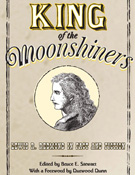King of the Moonshiners
Lewis R. Redmond in Fact and Fiction

- Author(s): Stewart, Bruce, ed.
- Series: Appalachian Echoes Non-fiction
- Imprint: Univ Tennessee Press
- Publication Date: 2009-02-01
- Status: Active
- Available in Paper: Price $21.95 | Buy Now
The “hillbilly hero” is an American archetype. Living a hardscrabble life in the mountains of the South, he turns to making moonshine in a homemade still, hidden from the prying eyes of the “revenuers”-the federal agents who pursue him because he doesn’t pay taxes. In reality a law-breaker, in our mythology the moonshiner is the hero who fights valiantly to eke out a living while being unfairly dogged by the “infernal feds.” Developed and embellished through more than a century of American popular culture, this image has put down deep roots in our collective psyche. King of the Moonshiners shows us how those roots first began to grow.
Lewis R. Redmond was an archetypal moonshiner. On March 1, 1876, the twenty-one-year-old North Carolinian shot and killed a U.S. deputy marshal who tried to arrest him on charges of illicit distilling. He then fled to Pickens County, South Carolina, where, within three years, he gained national notoriety as the “King of the Moonshiners.” More than any other individual moonshiner in southern Appalachia, Redmond captured the imagination of middle-class Americans. Then, as now, media coverage had a lot to do with his reputation.
This book includes three publications that helped to transform Redmond into a national celebrity. The first is a newspaper interview of Redmond, first published in the Charleston News and Courier in June 1878 and subsequently reprinted in newspapers throughout the country. This sympathetic portrayal made Redmond a household name. The second publication is Edward B. Crittenden’s 1879 dime novel (and fiction it certainly is), which solidified Redmond’s reputation as the most dangerous man in southern Appalachia. The third piece was written shortly after Redmond’s capture in 1881, allegedly to set the record straight.
As Bruce Stewart ably demonstrates, Redmond and his legend were the products of a specific historical moment: leaders of the “New South” wanted to shed the region’s hillbilly reputation while northern writers, looking for colorful stories, created a new and mythic version of Appalachia. Through these original documents, contemporary readers have the opportunity to relive that fascinating time.
